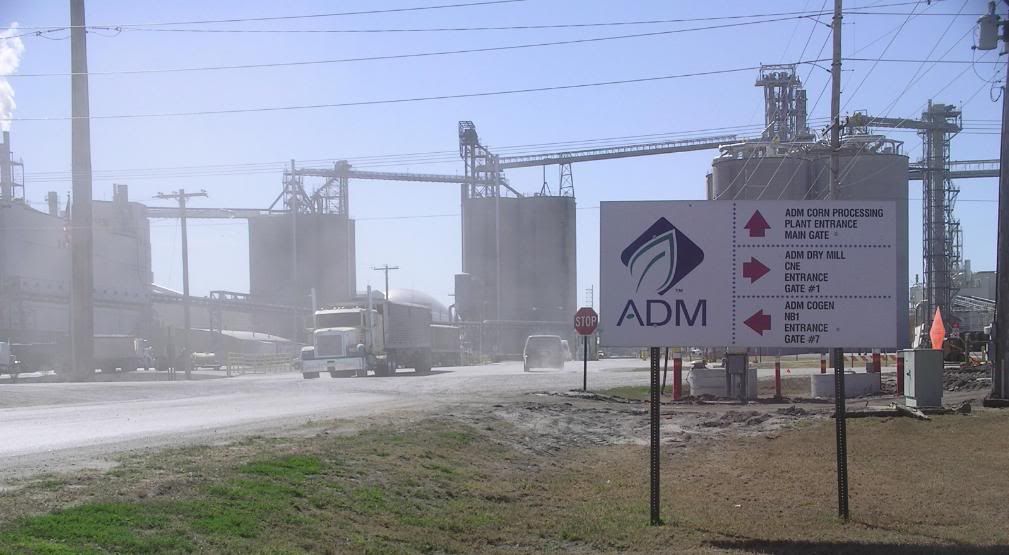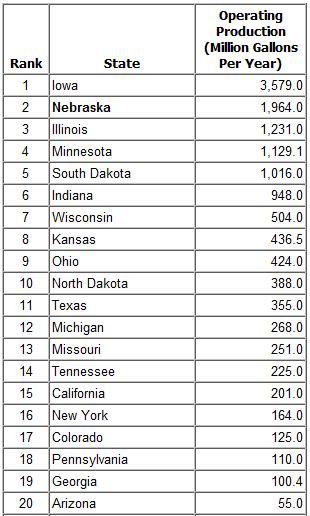
Twenty-eight states have ethanol facilities which are producing 14.2 billion gallons of corn ethanol per year. Iowa produces 25% of the nation's ethanol, and Nebraska comes in second, producing 14% or 1.96 billion gallons.

Sources: Renewable Fuels Association, Washington, DC.
Nebraska Energy Office, Lincoln, NE.
Data updated September 26, 2011
Having just returned from a trip to Eastern Nebraska, I feel as if I participated in a movie set for "The Road" or its equivalent. It's all about ethanol in this region of the country and it's not a pretty sight. Because of our unbridled and unquenchable thirst for liquid fuels, this policy is creating a vast environmental ruin not so different from that of the tar sands areas of Canada. In recent years, this land which was a prairie a short one-hundred-and-fifty years ago has become a region that produces primarily only two industrial agricultural crops, corn and soybeans.
Nebraska, of all places, should not be producing large volumes of ethanol, since it does so largely through the use of irrigation using Ogallala aquifer water. Using irrigated corn further lessens the energy return on energy invested of already low EROEI corn ethanol, since irrigation requires large inputs of generated electricity. Yet, it is the nation's second largest ethanol producer, turning out about two billion gallons per year.
These past few days, I watched as dust blew around the combines which are out harvesting in Nebraska's dry field conditions, causing at least one combine fire. Farmers are pleased with this season's relatively high crop prices even as agribusiness continually raises input costs as grain commodity prices rise. While we all wish for the economic success of the family farmer, the huge megafarms are profiting most from our subsidy system which encourages overproduction of our monoculture crops, and from our corn ethanol policy which is creating an artificial demand for corn.

When I took the above photo only two days ago, I watched as trucks full of corn were lined up more than twenty deep, to deliver corn to the ADM ethanol plant in Columbus, Nebraska. Several hundred of these trucks per day deliver the corn to be turned into ethanol at this huge facility. This particular plant uses coal in co-generation to help power its corn milling and ethanol processes. It is permitted to burn high and low sulfur coals, tire derived fuel, and biomass to produce steam and electricity. It is my understanding that this is the largest ethanol plant in the United States, which I assume makes it the largest one in the entire world. It sits next to the busiest freight train line in the U.S. and I watched many ethanol and grain railroad cars entering and exiting the area. The plant sits along the Platte River because its water requirements are also large.
Sadly, this ADM plant is in the middle of Ogallala aquifer center pivot irrigated corn fields, which produce consistently higher yields year after year, not being subject to the vagaries of natural rainfall. It also sits near the ever-shrinking rainwater basin of Nebraska, which historically provided waterfowl refuge and migration grounds for large numbers of birds, but it is now a small fraction of its original size as it's been replaced with cornfields.
Ethanol's use is mandated under the guise of improving air quality in the more populated urban areas of this nation. If it were actually a good product, mandated use would not be necessary and, for example, the state of Iowa which produces the most ethanol, but is not mandated to use it, would actually choose to consume large amounts of it, which it does not.
While our topsoils are being mined for this gasoline alternative, driving long distances to work in large vehicles is becoming more and more commonplace amongst the rural and small town residents who live in this region. Driving sixty miles to work isn't given a second thought these days to do work which is necessary to supplement or provide the family farm with income, or to locate between spouse's jobs which may be in towns set far apart. As the farms are becoming larger and larger and local services in the rural towns are disappearing, this need to drive farther is not surprising.
Growing industries in this region cannot find workers because the young adults leave this soulless ecological wasteland for areas which hold different values. I spoke to a manager of a large green energy manufacturer who described this to me. Their company is desperate for every level of worker, pays well, and faces an intense competition to find workers.
In addition, as another proposal for a tar sands oil pipeline to traverse Nebraska's Sandhills, farms, and underground aquifer gets national media attention, a similar pipeline is already in place which happened under the radar screen by paying off farmers along its way. It now travels just under the Elkhorn and Platte Rivers. Locals are aghast at what they've witnessed of the process.
In many miles of driving, I saw two deer cross a road and a few turkey vultures feasting on road killed racoons. That was about it for wildlife spotting in rural Eastern Nebraska over several days time. Since this is fly-over country, people are vaguely aware of the condition of the Midwest, but unless they actually see it, they can't visualize the boredom of this totally artificial landscape. This region is a bleak shadow of its former self.
Remember how upset and concerned U.S. citizens were about BP's Deepwater Horizon oil spill? That destruction was nothing, compared to the destruction of the Great Plains prairie ecosystem. Yet, no one covers this untold story, do they?
Soon, we will have the chance to change the farm policy in Washington. We don't need to produce this much corn. It's called overproduction. We need to phase out the ethanol program and certainly stop taxpayer funding of it. We need to start valuing our topsoil. Our ethanol policy is reducing crop rotation practices and other conservation agriculture methods. We need to preserve the quality of groundwater by ending the showering of chemicals onto our land for the production of these monoculture crops. We need to protect those who are attempting to grow organic or alternative crops from chemical drift, a prevalent problem plaguing the small producers.
It is time to increase the efficiency of personal transportation in this country. It's also time to start participating in our local governments to transition our towns from their car culture dependence. It will not happen unless our own voices are heard at the local level. Our very health is at stake, also greatly affecting our nation's economic balance sheet, since obesity due to inactivity is a medical epidemic. We need to design walkable neighborhoods and clustered, self-sufficient communities, even in farm country.
I'd like to see a farm policy which would mandate eat-local food co-ops as corner grocery stores in every town across America to replace the corn ethanol mandate and create new jobs and vitality in these areas. Grocery stores are a quality of life issue for small rural communities. For a good co-op model in a small Midwestern town, look at the one in Decorah, Iowa. If we established local food co-ops, we could create demand for alternative crops which would, in turn, support our small and family farmer. It would help change our values from "cheap food" which leads to obesity to quality food which encourages health and energizes our local community.
I love this land which was once prairie, and its history, including its history of its first peoples, so I rant because I am saddened. The new European settlers to this nation were poor, but they came to a country which was rich in resources. They faced great hardship and endurance, my ancestors included. Was this endpoint their goal?
I found some respite by walking the Sacred Hoop Prayer Garden at the John G. Neihardt Center one evening during my Nebraska visit.
Everything the power of the world does is done in a circle.Let us participate, as our circle leads us back to where we came. We are not on a road which leads us farther away from our native prairie. We are on a road which leads us back to it.
The sky is round and I have heard that the earth is round like a ball and so are all the stars. The wind, in its greatest power, whirls.
Birds make their nests in circles, for theirs is the same religion as ours.
The sun comes forth and goes down again in a circle. The moon does the same and both are round. Even the seasons form a great circle in their changing and always come back again to where they were.
The life of a man is a circle from childhood to childhood, and so it is in everything where power moves. Our teepees were round like the nests of birds, and these were always set in a circle, the nation’s hoop, a nest of many nests, where the Great Spirit meant for us to hatch our children.
---Black Elk, Holy Man of the Oglala Sioux 1863-1950
——Kay McDonald